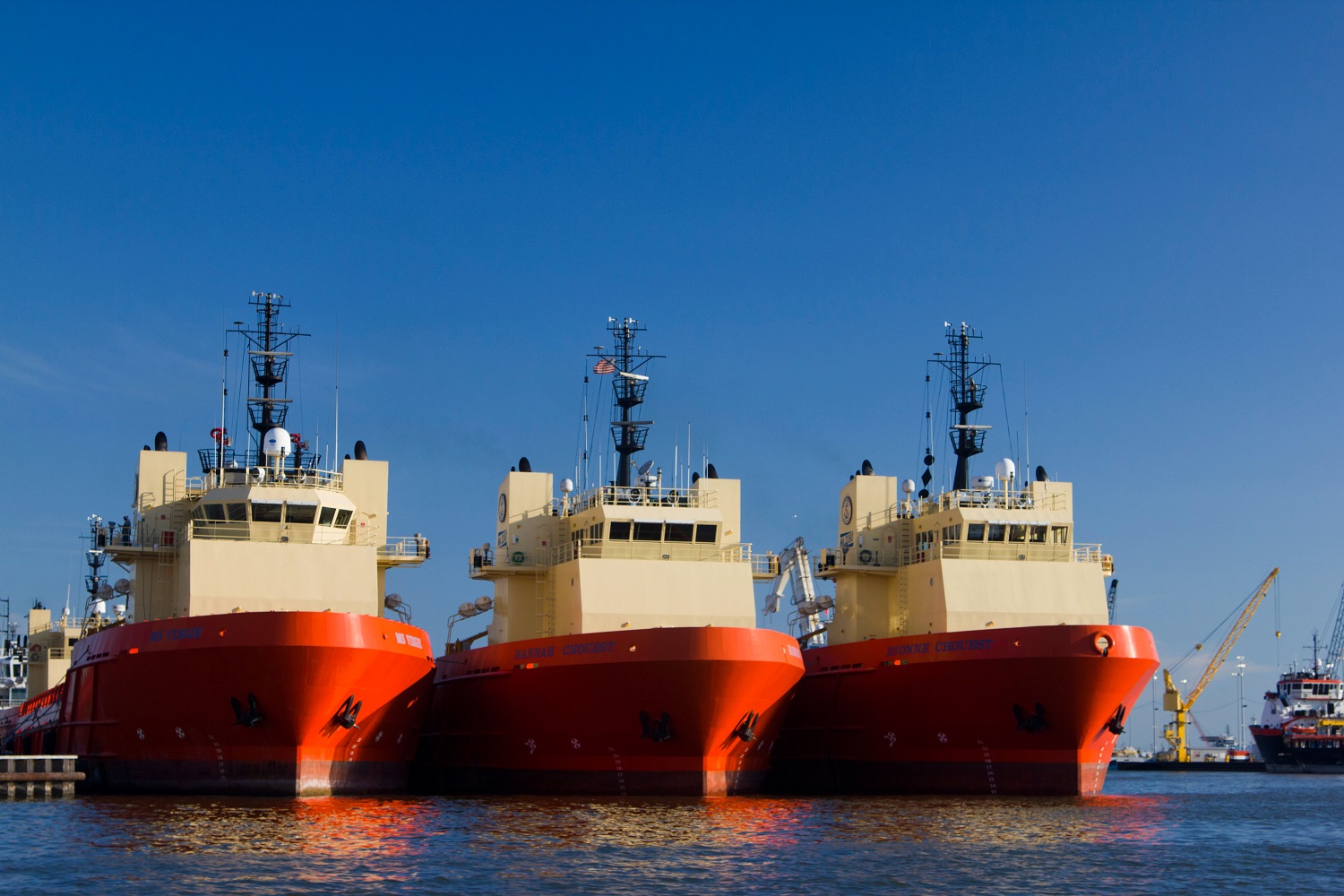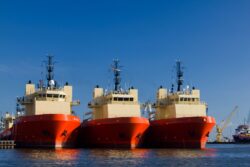Coastal
Port Fourchon
A facility providing an example of coastal cooperation
Published: February 28, 2021
Last Updated: September 1, 2021

Goss Images / Alamy
Edison Chouest Offshore (ECO) platform supply vessels at Port Fourchon.
When Paul Danos, 42, drives south to Port Fourchon these days, it’s usually for work: he’s the executive vice president of his family’s oilfield-service company, Danos.
As he drives, he thinks back to childhood outings here in Lafourche Parish, when his dad would pack the kids into the family car to go crabbing in the marsh. “We’d put the boat behind the truck and fill up the ice chest and stop at the local grocery to get ice and MoonPies and Coca-Colas and stuff we didn’t eat at home. Then we’d drive to Fourchon.” The ground on either side of Louisiana Highway 1 was solid marsh, dotted with a few little ponds.
These days, it’s one of the fastest-eroding areas in the world, because of rising sea levels, sinking land, and salt-water intrusion hastened by crisscrossing channels that were dug through the marsh for energy exploration and pipelines. These days, even modest rainfall and high tides will flood the last stretch of Highway 1 that leads to Fourchon Island, where the port is located.
That forces Danos to take a different route. Once he reaches the small town of Leeville, a full eleven miles before Port Fourchon, he leaves the ground-level highway, driving up a ramp that takes him twenty-two feet into the air, onto a span of elevated highway that connects Leeville to the port. As he drives, he sees nothing but seawater through his windshield. “In my years on the coast, I’ve seen a tremendous change,” Danos said. “Areas that used to be island and marsh and very fresh water have turned into open water.”
The shift in landscape is evident to Chett Chiasson, also 42, who heads up the Greater Lafourche Port Commission. “I’ve watched the marsh washing away all my life,” he said. “So it’s personal.”
For both men, it’s also business. This disintegrating part of the coast is anchored at the Gulf of Mexico by Port Fourchon, which is considered an essential part of the nation’s energy infrastructure because it services 90 percent of deepwater rigs and is key to the production of nearly 20 percent of the nation’s oil. “If we didn’t have industry at Port Fourchon, Fourchon Island would not be there,” Chiasson said.
Now the two old friends, who grew up along Bayou Lafourche and have known each other since junior high, are helping to save their home community. About a year ago, they helped to form a coalition called the Partnership for Our Working Coast, which is now being seen as a case study for how industry can work with communities to benefit the environment. Along with Danos and the Port Commission, the coalition includes oil companies Chevron and Shell and the Water Institute of the Gulf, a nonprofit that specializes in coastal-science research.
Working alongside them is environmentalist Simone Theriot Maloz, 40, a native of Terrebonne Parish—“up a different bayou”—who heads up Restore or Retreat, a nonprofit group advocating for the needs of the disappearing Louisiana coast. “We use Port Fourchon as an example where the energy industry meets the environment,” she said. “We’re not working together because it’s the right thing to do. It’s what we have to do. We are part of a generation who grew up on this working coast. So we know how important it is to protect this environment.”
The coalition is now hoping to use eight million cubic yards of dredged sediment to rebuild marshland in lower Lafourche Parish, just north of the port. They are building upon a past success, a marsh-rebuilding project coordinated by the port twelve years ago with the Barataria-Terrebonne National Estuary program. Using sediment piped to the area from a port expansion, with trees, seeds, and grass plugs planted by oil-and-gas industry volunteers, they rebuilt about six thousand linear feet of the historic Fourchon maritime forest ridge, Chiasson said, noting that the researchers monitoring the ridge have determined which plants best grow within the coast’s current salinity and provide habitat for threatened coastal shorebirds such as the red knot and piping plover.
It’s a perfect marriage: the eroding marsh needs sediment. And the port steadily dredges, as it expands or deepens its slips. The Water Institute is modeling to determine the best places to put the dredged material. Since it’s fine-grained—more mud than sand—the sediment can’t be used on beaches, where the waves would quickly wash it away, said Ryan Clark, a coastal geologist at the Institute. To use the sediment most efficiently, they have proposed to fill in places where the water is shallow and still contains some remnant of marsh. The partners are even examining ways that the project can generate so-called Blue Carbon credits, because wetland restoration increases the amount of stored carbon.
The last time that Danos visited Port Fourchon, he and Chiasson talked about their daughters, both seniors in high school who are debating where to go to college. It’s those kinds of conversations that ultimately drive the work of the Working Coast partnership. “The culture here, the connection to community and family, it paves the way to have these kinds of partnerships, which are truly more than business transactions,” Danos said. “We’re thinking about the next generation of kids who will go away to school and may or may not come back here. If we don’t invest in their future, they won’t have anything to come back to.”
Katy Reckdahl is a New Orleans news reporter who is a frequent contributor to the Times-Picayune | New Orleans Advocate and WDSU special broadcasts. Her stories have appeared in National Geographic, Next City, the New York Times, Atlantic, and Christian Science Monitor.
 This article was made possible by the BHP-funded project, Coastal Impacts: An Integrated Approach for Community Adaptation, Understanding, and Planning, which will assist local communities to build intergenerational coastal literacy through community conversations around books, film, and exhibitions, fostering greater understanding of and support for coastal restoration projects.
This article was made possible by the BHP-funded project, Coastal Impacts: An Integrated Approach for Community Adaptation, Understanding, and Planning, which will assist local communities to build intergenerational coastal literacy through community conversations around books, film, and exhibitions, fostering greater understanding of and support for coastal restoration projects.
